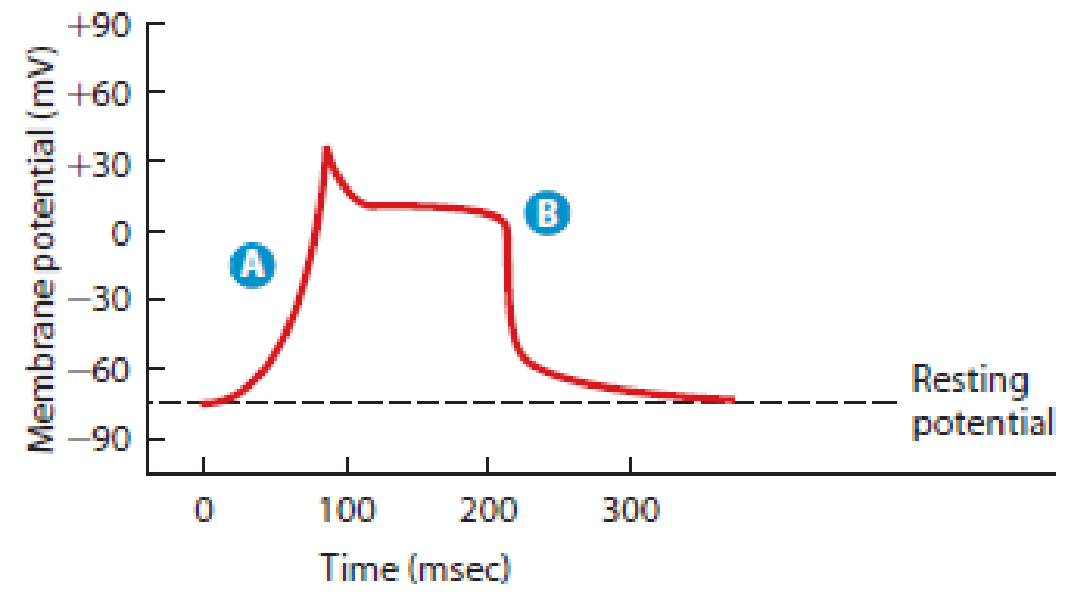
QUANTITATIVE Heart Throbs. An understanding of muscle cell stimulation involves some of the same principles as nerve cell stimulation, except that calcium ions play an important role in the former. The following ion concentrations are typical of those in human heart muscle and in the serum that bathes the muscles:
Figure 22-19 depicts the change in membrane potential with time upon stimulation of a cardiac muscle cell.

Figure 22-19 The Action Potential of a Muscle Cell of the Human Heart.
See Problem 22-5. (a) Calculate the equilibrium potential for each of the three ions, given the concentrations listed.
(b) Why is the resting membrane potential significantly more negative than that of the squid axon (−75 mV versus −60 mV)?
(c) The more positive membrane potential in region  of the graph could in theory be due to the movement across the membrane of one or both of two cations. Which cations are they, and in what direction would you expect each of them to move across the membrane?
of the graph could in theory be due to the movement across the membrane of one or both of two cations. Which cations are they, and in what direction would you expect each of them to move across the membrane?
(d) How might you distinguish between the possibilities suggested in part c?
(e) The rapid decrease in membrane potential that is occurring in region  is caused by the outward movement of potassium ions. What are the driving forces that cause potassium to leave the cell at this point? Why aren’t the same forces operative in region
is caused by the outward movement of potassium ions. What are the driving forces that cause potassium to leave the cell at this point? Why aren’t the same forces operative in region  of the curve?
of the curve?
Trending nowThis is a popular solution!

Chapter 22 Solutions
Becker's World of the Cell (9th Edition)
- Problem. A 1-year-old child was admitted to the clinic with signs of damage to the muscles of the limbs and trunk. After the examination, carnitine deficiency in the muscles was revealed. Disruption of which transport process is the basis of this pathology? Explain the mechanism of this transport.arrow_forwardHello, good day. I have a problem answering this question, and I need your help. Hoping for a response, and thank you so much. Instruction: The answer must be in a minimum of 2 paragraphs, and each paragraph must have a minimum of 4 sentences. Question: What is the shape of a cardiac muscle cell?arrow_forwardPlease don't reject this. I really need the answer for this. Name and discuss the functions of three rotationally driven medical equipment purposed for diagnoses and treatment. Provide an illustration.arrow_forward
- A healthy woman 45yrs.old exercises on her treadmill. First walks for 5 minutes to warm up, she then jogs for 5 minutes, runs for 15 minutes and jogs for another 5 minutes to cool down. Explain how her pulse rate changes during the course of her exercise routine?arrow_forwardCongratulation. You just graduated and obtained a job as an RN at NYU Medical Center. A patient comes in complaining of nausea, vomiting and weakness. You obtain the vital signs: T 90, P 90,R 20 and BP 100/70.His weight is 130lb and BSA is 2.60 m2. After history and physical examination, the physician ordered an infusion. The order reads: a drug 100mg/m2 IVPB IN 250mL of Normal Saline infuse over 3hours.The drug is available in a vial labeled 60mg/ml. At what rate in mL/h should the pump be set? Attach File Browse My Computer Browse Content Collection Browse Dropboxarrow_forward. Intracellular concentrations in resting muscle are as follows: fructose- 6-phosphate, 1.0 mM; fructose-1,6-bisphosphate, 10 mM; AMP, 0.1 mM; ADP, 0.5 mM; ATP, 5 mM; and P;, 10 mM. Is the phosphofruc- tokinase reaction in muscle more or less exergonic than under stan- dard conditions? By how much?arrow_forward
- Among the given statements. which ones are true for hemoglobin? Select the correct response(S). It has ferrous cation that is coordinated by the electrophilic N atoms of the porphyrin ring. It has 4 sub-units with each sub-unit binding an oxygen molecule with the same efficiency. It has 4 sub-units with each sub-unit binding an oxygen molecule in an increasing efficiency. It has ferric cation that is coordinated by the electrophilic N atoms of the porphyrin ring. It has 4 sub-units with each sub-unit binding an oxygen molecule in a decreasing efficiency. It has ferric cation that is coordinated by the nucleophilic N atoms of the porphyrin ring. It has 4 sub-units with each sub-unit binding an oxygen molecule in a fluctuating efficiency.It has ferrous cation that is coordinated by the nucleophilic N atoms of the porphyrin ring.arrow_forwardDo quickly. A 2 liter IV is to be infused in 24 hours. what is the necessary infusion rate in ml/hrarrow_forwardof being active. Explore Activity: MY FITTness PLAN Direction: Using the table below, make your own FITTness plan for cardiovascular endurance and muscular endurance. Write your answer on the boxes provided. Cardiovascular Endurance Frequency Intensity Time Туре Muscular Endurance Frequency Intensity Time Туреarrow_forward
- PHARMACOLOGY IN PRACTICE PHYSIOLOGY Which of the following statements are true in regards to nitrates? Select all that apply. 1. Relax the smooth muscle layer of blood vessels 2. Increase the lumen of the artery or arteriole 3. Slow the conduction velocity of the cardiac impulse 4. Depress myocardial contractility 5. Increase the amount of blood flowing through the vesselarrow_forwardPlease asap. Thankyou. Question 8 If the concentration of Na+ inside of a cell increases, the Nernst potential for Na+ will do what? Become more positive Become more negative Not change Not surearrow_forwardin the simple two stimul ion. Name: Year and Section: EXERCISE NO. 12 II. Define summation. Summation RESULT/OBSERVATION I. Draw a summation and label its phases. 183 Date Submitted: Group No.:. A- B- C- AB - BC- CD-arrow_forward

